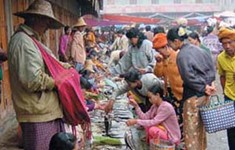
Rising regional and global demand for seafood means Burma (officially known as Myanmar) has a good chance to rebuild its tilapia industry while also cultivating export-friendly species like sea bass, according to Lukas Manomaitis, president of the Asia Pacific chapter of the World Aquaculture Society and an advisor at Bangkok-based Seafood Consulting Associates. He believes economic reforms and low labor costs will help Burmese aquaculture output return to the 25 percent per-year growth rate it saw in the ten years up to 2008, when a cyclone devastated much of the country's coastline.
Patchy infrastructure and power shortages remain challenges, yet “… government seems ready to listen to good ideas and industry appears to desire to work towards a rapid development of aquaculture,” says Manomaitis who meets frequently with the country’s Ministry of Fisheries, currently working on a national fisheries plan.
The export potential of Burmese aquaculture was long blunted by an export tax as high as 12 percent, which has recently been cut to 2 percent. Whereas previously much of the country’s exports focused on grey channel shipments to neighboring Bangladesh and shipments of Indian carp to the Middle East, Manomaitis notes there’s lately been shipments of snake head, shrimp and yellow croaker to China.
Western isolation of the Myanmar regime, up till recently, means neighboring states like China and Thailand have had a head start. Thai Union Feedmill, for instance, imports aquafeed. Likewise, Manomaitis has encountered private Chinese interest training locals on cultivation of snake head, for export to China. Shrinking space in China for land and sea-based aquaculture makes Burma’s long coastline particularly attractive for Chinese investors whereas “all that’s need in Burma is investment, and China is cash rich right now.”
The country’s longtime economic isolation has meant local aquaculture production has been out of tune with broader export market trends, yet Manomaitis sees an appetite to improve and increase production of bass and tilapia. Destroyed by Cyclone Nargis in 2008, the local tilapia industry remains limited, says Manomaitis. Likewise, he says, there’s much potential for a ramp up in shrimp output, currently consisting of extensive monodon (black tiger) and some intensive vannamei (Pacific white) shrimp.
Clearly there’s much work to be done. Manomaitis found during a 2012 meeting in Singapore that he organized for two Burmese feed companies that half of the aquafeed industry remains non-operational. However he sees a “huge desire” among locals to learn the latest techniques on hatcheries and disease control. The Myanmar Shrimp Association and the Myanmar Fisheries Federation, both private bodies, have embraced the new interest in Burma. “They said to us, ‘welcome to you for bringing knowledge and technology to Burma, no one ever bothers to visit us!’”
As the Asia representative of the American Soybeans Association (ASA), Manomaitis is keen to develop the Burmese market for soy-based fish feed. Having appointed a local representative, May Myat Noe Lwin, in 2010, well before the current reform process transforming the country, Manomaitis believes the local feed industry is open to new ideas.
“There are signs that local feed mills are advanced, the key aquafeed players like Htoo Thit and Wah Wah Win use extruders to create floating feeds. Htoo Thit, which produces 50,000 of floating feed per year, is ahead of more cost-focused counterparts in regional aquaculture powerhouses like Indonesia. Farmers there mistakenly see this as a way to save costs but the best approach would be to determine the return for best cost of a kilogram of fish produced, not just choosing the least expensive feed … in Myanmar it appears the farms already made the determination that floating feed is worth the extra cost.”
China is “very interested” in Burma's aquatic resources and “almost certainly” has reached an access agreement with Burmese authorities to allow Chinese vessels use its waters, says Simon Funge Smith, Asia fisheries officer with the FAO. Yet China may not be the ultimate demand driver for ramped-up Burmese production. While Chinese demand for premium product and reef fish remains strong China, according to Funge Smith, is seen as a “low value” market for Southeast Asia’s aquaculture sector, which still looks to the EU and US for higher prices. Increased interest from international investors has driven up the value of Burma’s currency, blunting some of its competitive advantages. A free trade agreement between China and ASEAN (of which it's a member) entitles Burma tariff-free access to the Chinese market.





